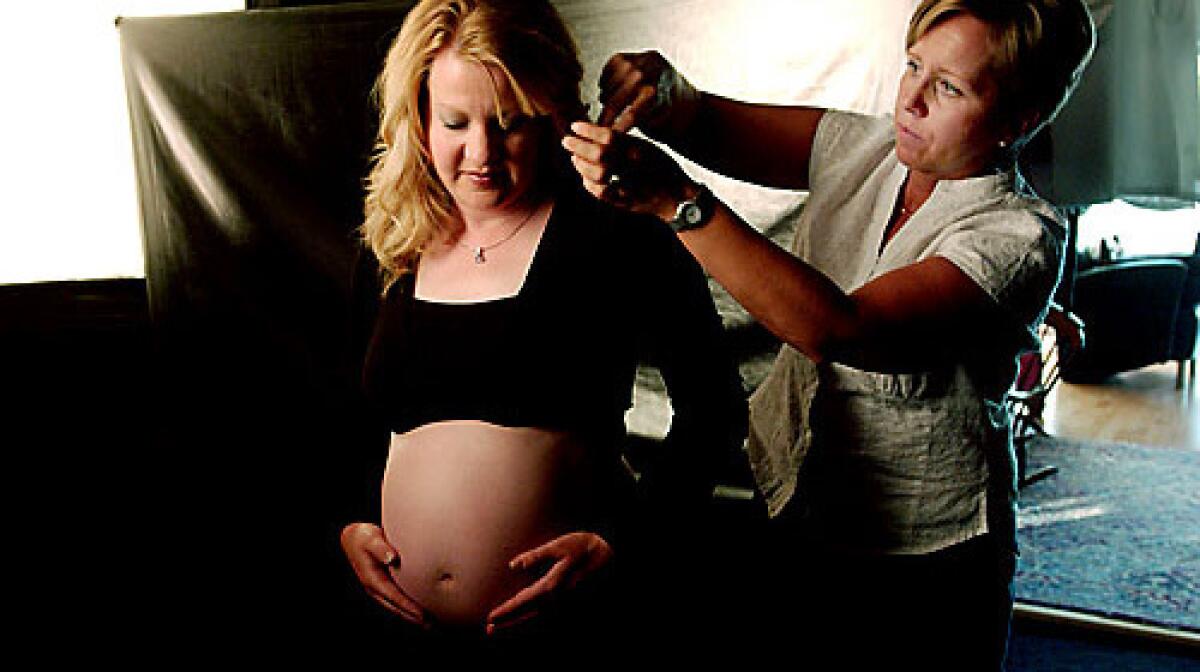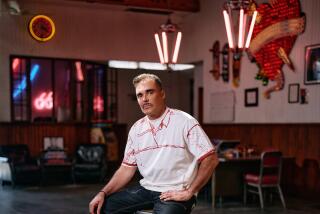Capturing final, precious moments

- Share via
DENVER — In the muted light of the maternity ward, photographer Sandy Puc’ works steadily, composing portraits of David. She focuses on his tiny toes, his curled fists, his mother gently stroking his cheek.
“I think I got everything,” she says at last. Then she turns with her Canon.
“If you want to put your lips right on the top of his head?” she asks David’s father. “There. That’s beautiful.”
There is always a final kiss to capture.
David was stillborn early this morning, without kidneys or working lungs. His parents, Gina and Rob Harris, will take home his plastic hospital bracelet and his blue blanket, embroidered with stars. They will try to hold onto their memories, but those will blur, and they will turn to these portraits: Gina nuzzling David’s hair, so dark and curly, just like his dad’s. Rob bending to dress his son.
Sandy knows what the pictures will mean; that’s why she has come and stayed all night. A photographer who teaches portraiture worldwide, she also runs a volunteer network dedicated to photographing dead and dying infants.
Many hospitals offer bereavement photography when a newborn dies; typically, a nurse will snap a few pictures and package them into a memory box, along with a lock of the baby’s hair, a plaster cast of her hands and inked footprints. For some families, that’s enough, or too much.
But many parents want more. Scores of calls each week come into Sandy’s nonprofit network of more than 3,000 professional photographers from all 50 states. The photographers donate their time and work, leaving each family with dozens of images:
A girl leaning in to kiss her brother. A mother cupping premature twins in her hands. A father holding his baby girl against his shoulder for one last dance.
The first time she was asked to photograph a dead baby, Sandy wanted to say no.
A couple she’d never met, Mike and Cheryl Haggard, had called her portrait studio to ask that she photograph their failing newborn, Maddux.
A mother of four, Sandy, 37, had spent a year in the hospital with her youngest son, who suffered from a breathing disorder at birth. “I couldn’t let a parent in that situation down,” she said. When she got to the hospital, Mike and Cheryl told her they planned to disconnect Maddux from life support. They would hold their son until he died. Then the Haggards would bring in Sandy to take his portrait.
“I felt like a wrecking ball hit me,” Sandy said. She wasn’t sure she could hold herself together.
An hour later, a nurse called her to the Haggards’ room. Sandy entered to see Cheryl holding Maddux to her chest, skin to skin, grieving, but at peace. Focusing through eyes blurred with tears, Sandy took frame after frame.
“Do you know what you’ve given me?” Cheryl asked her later, when she’d seen the portraits. “You’ve given me my son.”
Cheryl, a stay-at-home mom, and Mike, who runs a business removing dents from cars, had taken a few pictures of their son during his six days of life. Those images, Cheryl said, are raw. They show Maddux’s yellowish skin tone, and the wires that snaked around him as doctors fought to keep him alive despite an underdeveloped brain.
“They’re not pictures I go back and look at often,” Cheryl said. “Those photos are reality. I don’t need reality. I’ve lived it.”
Sandy and the other volunteers retouch their portraits to smooth skin tone and hide bruises, though they will not airbrush out deformities. Their portraits, in black and white, are soft and luminous, elegiac. The infants look as though they are sleeping.
On the network’s website, parents say that approach helps them remember their children the way they want to remember them: “Like the angelic babies that they are,” one mother wrote. “Perfect in our minds,” another said.
Sandy’s portraits of Maddux, who died Feb. 10, 2005, hang in the Haggards’ house, alongside framed photos of his three siblings.
“He has a place in our family,” Cheryl said, “now and always.”
Three weeks after Maddux died, Sandy got a call from one of her longtime clients, pleading with her to photograph a newborn nephew in critical condition. Sandy took the pictures but the baby was tethered to tubes and IVs; he looked frail and alone. She didn’t know how to tell the parents that she could take more tender portraits after he died.
“I felt like I was cheating them,” she said.
She talked about the experience with Cheryl, who had become a friend. Both decided they wanted to find a way to spread the word about bereavement photography. Sandy already did charity work, holding regular events at her studio to benefit Children’s Hospital, but this felt like a more personal way to give. In April 2005, two months after Maddux’s death, she and Cheryl launched a nonprofit. They called it “Now I Lay Me Down to Sleep,” after Cheryl’s favorite bedtime prayer.
Sandy took her pictures of Maddux to hospitals across Denver. The calls began coming at once. She remembers a blur of sweet faces, and the babies’ names: Daniel, George, Giselle, Maria, Michael, Samantha, Faith, Heaven, Hope.
After six calls in one two-day period, Sandy realized she couldn’t do it all alone. She began recruiting professional photographers at the portraiture seminars she teaches nearly every weekend. As the network took off, she sent brochures to hospitals in every major city and promoted the service at medical conferences.
Sandy worries, sometimes, that her photography sessions have become too routine. “I don’t want to become calloused,” she said.
That first time, with Maddux, she took every angle she could imagine, so she wouldn’t miss a shot his parents might cherish. Now, she knows which poses work best; she can wrap up a session in 15 minutes, though if the family is comfortable, she may spend longer. She no longer grieves over each baby.
“But sometimes,” Sandy says, “it just hits you.”
One recent morning, she was in her studio taking portraits of a chubby 6-month-old. The little girl was gurgling, playing with her toes, and Sandy thought of the still, silent babies she has photographed.
She had to put down her camera.
Sandy found photography by chance: She was 17 and working as a nanny, and the parents asked her to take snapshots of their kids. To her surprise, she was so good at it that her employers’ friends began hiring her to take portraits of their children.
Over the years, Sandy married and raised her own children, and continued to take portraits for fun. After their youngest was born, her husband, Edward, a chef, told her he would take a turn at home so she could build her hobby into a career.
Eight years later, Expressions Photography occupies a 20,000-square-foot studio in the Denver suburb of Littleton. Sandy employs a staff of 26; assistants hold her strobe light and arrange props when she shoots.
On a warm October afternoon two months before their due date, Gina and Rob Harris arrived at the studio, looking dazed as they took in the baroque decor: gold walls, maroon drapes, portraits everywhere, in ornate gilded frames.
“I’m a nervous model,” Gina said, staying close to her husband.
A mid-pregnancy ultrasound had revealed a fatal kidney disorder in David, their first child. Gina’s doctor recommended abortion. She remembers her response: “I believe in a God bigger than that.”
“We want the opportunity to hold our baby,” said Gina, 32, who runs an abstinence education program.
“He’ll have a face and a name instead of being a ‘what if . . .,’ ” said Rob, 35, who coaches football at a Christian high school.
A friend told the couple about Now I Lay Me Down to Sleep. Rob couldn’t look at the photos on the website. But Gina studied them, and decided to call. When Sandy suggested she come in for a free maternity shoot -- glamorous shots of her rounded belly -- Gina was hesitant, but she agreed. She’d have David for such a short time, she felt she should preserve every memory.
A whirl of energy who favors black clothes and burgundy toenail polish, Sandy ushered the Harrises into her studio, cluttered with props: silk flowers, a rocking horse, a blue velvet couch, satin angel wings, a fake fireplace. “We’re going to have a little fun with this,” she said.
She positioned Gina against a white backdrop.
“You’re going to go tummy-to-tummy,” she instructed Rob.
“Do we smile?” Gina asked anxiously.
“In this situation, we want to keep it nice and soft,” Sandy said. “Look down toward your tummy. Chin out . . . that’s beautiful.”
Three weeks later, on Oct. 24, Sandy got a late-night call. Gina had gone into labor. By 11:30 p.m., the photographer and her assistants had arrived at Exempla Saint Joseph Hospital in downtown Denver.
Gina asked that they photograph David as soon as he was born because he was expected to live only a few minutes. Sandy promised to be ready. Then her team retreated to a conference room.
They organized their 2008 appointment books. They played a few desultory games of tick-tack-toe. By 2:15 a.m., Sandy had given up trying to stay awake. She stretched out on the floor, her leather jacket wrapped around her, a “Law and Order” rerun on TV.
An hour later, a nurse woke her to say Gina was about to deliver. Standing in the hall outside Room 10, waiting, Sandy and associate photographer Helen Noakes talked about their hospital calls, remembering other babies who didn’t go home.
“She was just beautiful, perfect in every way,” Sandy said, her voice low.
“Her parents put her in a yellow dress,” Helen said. “I remember that yellow dress.”
It was nearly 4 a.m. when a nurse came out to tell them David had been stillborn. His parents were taking some time alone with him.
Twenty minutes later, the nurse beckoned the photographers to begin. Helen held the strobe light while Sandy circled the hospital bed, taking pictures. The camera sounded loud in the hush, but Gina barely glanced up. “So cute,” she whispered, kissing her son. “Look at his cheeks.”
A nurse leaned in to gently close the baby’s open mouth.
“Can I get a picture of his backside?” Sandy asked, and the nurse helped position David on his stomach, curled up in the blue blanket.
Drawing on the bond she felt with Gina after the maternity session, Sandy worked for nearly an hour, taking more than 150 images of David. “Beautiful,” she kept saying. “He’s beautiful.”
Dawn was breaking when Sandy packed up her camera. She’d have to head to the studio soon; the day was booked solid with families requesting holiday portraits. She’d be making a lot of little kids giggle.
But she’d have to find time, too, to edit her images of David. She wanted Gina and Rob to have those portraits before they buried their son.
More to Read
Sign up for Essential California
The most important California stories and recommendations in your inbox every morning.
You may occasionally receive promotional content from the Los Angeles Times.









